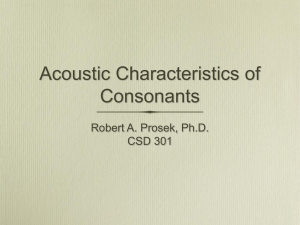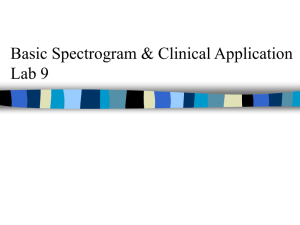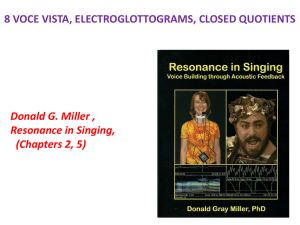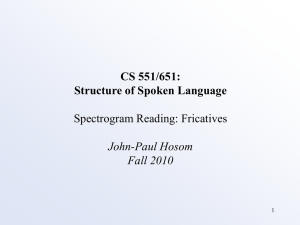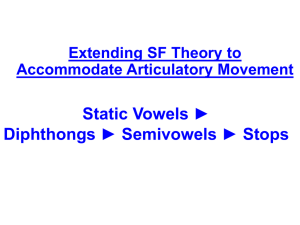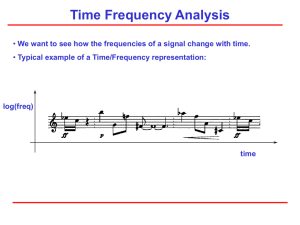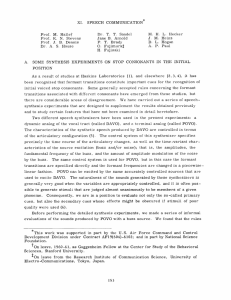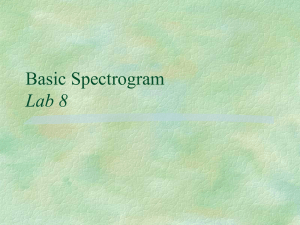Lab 10
advertisement
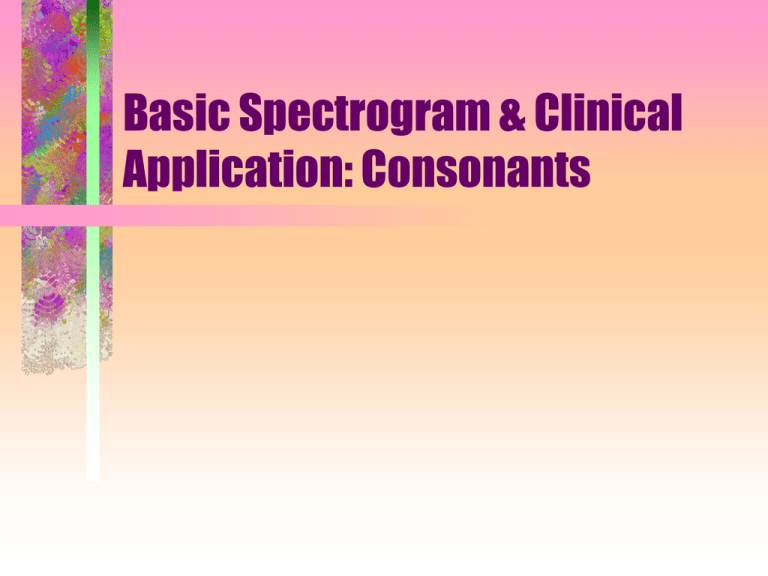
Basic Spectrogram & Clinical Application: Consonants Sonarants • Consonant that manipulates vocal tract resonance • Characteristics – F2 & F3 formant changes – Transitions • Include: – Nasals /m/, /n/ & /h/ – Liquids /r/, /l/ – Glides /w/, /j/ Sonorants • Production involves a greater constriction when compared to vowels and a quicker more extreme movement of the vocal tract compared to diphthongs • Movements and formant transitions slower than all other consonants Nasals • Low frequency energy (near Fundamental Frequency)- Nasal Murmer • Place of nasal articulation is defined by the 2nd formant transition & place of antiresonances m a Nasal Murmur Spectrogram: Nasals n a Glides • Semivowels /j, w/ • Gradual transitions that appear on the spectrogram as a slowly changing formant pattern – Formant transitions: • Duration= 75-150 ms Spectrogram: Glides Liquids • Liquids /l, r/ • Formant pattern steady state and transition is the primary acoustic cue – Prolongation effects • /l/ steady state formants – F1= 360 Hz – F2= 1300 Hz – F3= 2700 Hz • /r/ steady state formants – Same F1 & F2 as /l/ but much lower F3 Spectrogram: Liquids r l Stops – Acoustic Cues: Silent or low energy interval, burst, transition • Silent interval = oral constriction (I.e. closure of lips for /b/); also termed a stop gap – Voiced stops can be seen on the voice bar as noise energy • Burst = Articulatory constriction is released; energy released looks like noise on the spectogram • Transition= formant transition into following vowel Stops • Bilabial Stops (/p/, /b/): – F1 starts at zero & rises to F1 of next vowel – F2 starts at 800 Hz & rises to F2 of following vowel – F3 increases for following vowel • Alveolar Stops (/t/, /d/): – F1 same as for bilabial stops – F2 starts at 1800 Hz & rises to F2 of following vowel • Velar Stops (/k/, /g/): – F1 same as for bilabials – F2 has 2 starting points 1300 & 2300 Hz Spectrogram with Transitions: /d a d/ Voiceless Stop Consonants Stops • Characteristics: – Voice onset time (VOT)= time between stop release (burst) and the onset of glottal pulsing • Voiced= shorter VOT • Longer VOT in cleft palate, dysarthric speakers and phonological disorders Fricatives • Spectrum of noise is the acoustic cue & formant transition • Specific location of turbulence – Labiodental /f,v/ • Low energy, flat diffuse spectra (front cavity is short with little filtering effect on noise energy) – Linguadental /q,ð/ • Low energy, flat and diffuse spectra (front cavity gives little shaping to spectrum) – Lingu-alveolar /s, z/ • High energy noise spectra, energy lying in high frequencies (above 4 kHz) (front cavity longer contributing to distinctive spectral shaping) – Linguapalatal /sh, zh/ • Intense noise spectra, energy lying in mid to high frequencies (above 2kHz) (front cavity significant resonance effect) Spectrum: Changing Pattern of Fricative Noise Fricatives: Spectrum Higher energy spectra Low to mid energy spectra Affricates • Affricate consonants have a stop gap (silence, low energy interval) followed by intense frication – Stop gap= articulatory closure – Frication= noise after closure is released Spectrogram: /judge/ Laboratory • Part I: SONORANTS: – Nasal Consonants • Make a wide-band spectrogram of: • “mow”, “no” – Draw a vertical line where consonant ends and vowel begins – Locate nasal murmer, 1st & 2nd formants, antiresonances – What spectral differences do you see? – Locate the 2nd formant transitions on both. What are the differences? • “Some”, “Sun” – Label the same as the first spectrogram • Contrast both spectrograms Laboratory • Part II: Approximants – Glides & Liquids • Wide band spectrogram of “a ray”, “a lay”, “a way”, “a yea” • Label each phone on the spectrogram • Compare /r/ & /l/ • Determine the relative frequency of F1, F2 & F3 • Determine whether there is acoustic energy present at higher frequencies is low or high • What acoustic characteristics are different between consonants? Laboratory • Part III: Silibants – Fricatives • Say “sigh” and “shy” at a moderate rate • Obtain a wide-band spectrogram (at least 8 kHz) • Locate & label each phone • What are the spectral characteristics that distinguish it from vowels and other consonants? Laboratory • Part II: Nonsilibnts – Obtain a wide-band spectrogram of “high”, “fie” and “thigh” • Label each phone • What spectral features distinguish phones? • How do they differ from silibants? – Obtain a wide-band spectrogram of “ether” and “either” – Label

